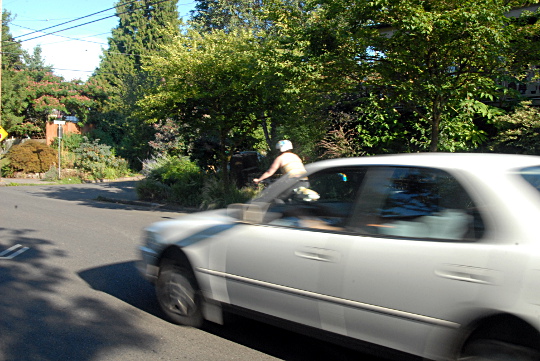As we wrote beneath the last Comment of the Week post, BikePortland has decided to be the only blog we’re aware of that pays for great comments. The person whose thoughts we select for this feature gets a crisp $5 bill in the mail, as a way for us to appreciate the site’s amazing discussion community. So watch your email — we might be in touch.
Street safety matters to cities. So does street comfort. But only one of those issues will land you in court.
That’s the insight shared this week by BikePortland reader paikiala, responding to the discussion on Wednesday’s post about a guerrilla traffic diverter installed on Clinton by anonymous activists.
Paikiala, who often weighs in with thoughts about a city’s perspective, was responding to another reader who asked why “safety issues” stemming from Clinton’s high auto traffic hasn’t awoken the city’s fear of a lawsuit.
Advertisement
Here’s paikiala’s data-rich reply:
You’ll need to clarify what the safety issues are, or perhaps you mean the fear of safety issues? There is no need to worry, because frequently the City is sued regardless of the events of a collision simply because of the deep pockets and distribution of responsibilities that typically result from trials. This is also why the City, prudently, negotiates settlements to avoid going to trial. That said, much of PBOT’s efforts go into making roads safer.
‘Safety’ is a subjective word. In the last ten years there have been twelve reported bike involved crashes on Clinton between 12th and 50th, representing 12% of the reported crashes. Of those 12, 7 (58%) were blamed on motorist errors while 5 (42%) were blamed on cyclist errors – all crashes involved injury to cyclists.
Clinton has been retrofitted more than once (three times in the last 20 years) to alter the patterns and behavior of users. This process is happening all over the city on an annual basis where problems are occuring as resources permit. Citizens of portland see their local street or commute problems, while City workers see the problems of the City as a whole. The perspective is different.
What guidance are you citing? If you mean the most recently adopted ideal plan, true. But most streets fail to meet new policy every time new policy is adopted. It takes time to massage current systems into the new paradigm.
Lastly, regardless of those that say ‘do both’, daily PBOT front line staff is faced with choices. Say you’ve got $80k today to do what you want with for traffic safety in Portland. Do you add 2-5 diverters on a single greenway (that’s not so bad), or do you add one rapid flash beacon ped crossing (without refuge island) on a busy road in east Portland? You choose, and be prepared to defend your choice in court.
America’s tradition of litigation has been a huge shaping force behind the scenes of our society. Sometimes that’s for the better and sometimes it’s not. But as the bicycle advocacy priorities in this country have shifted further from safety and closer to comfort, it’s clear that there are some things litigation may no longer be able to help with.



